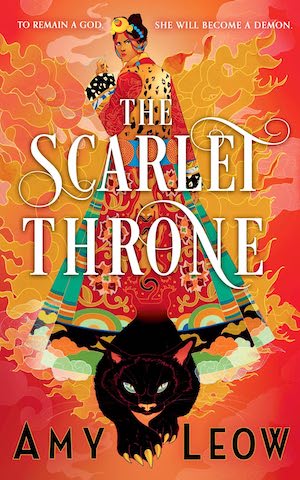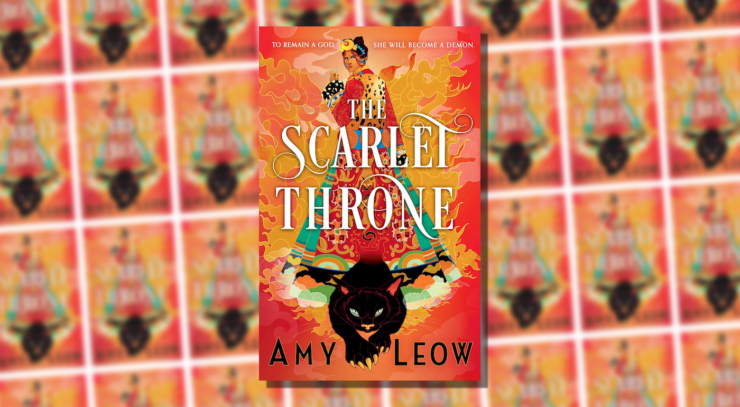The Scarlet Throne, Amy Leow’s debut novel, is inspired by the culture of Nepal and the tradition of “living goddesses.” It focuses on Binsa, a young woman who has been a “living goddess” since she was a child, who is supposed to be the ritual avatar of a goddess and dispense justice and mercy from the titular Scarlet Throne.
Fortunately or unfortunately for Binsa, she’s not the avatar of the goddess Rashmatun that she’s supposed to be. Instead, thanks to her (now deceased, thanks to Binsa) mother—who also arranged for all her potential competitors for the role to perish during the ritual that chose Binsa as a living goddess —Binsa plays host to a demon instead, one over whom she exercises very little control. Ilam, the aforesaid demon, is three parts vicious force of nature to two parts contrary and reluctantly domesticated semi-feral cat.
When her temple’s priests decide that Binsa has occupied her role for too long, a new girl is chosen to take her place. Pre-teen Medha appeals to Binsa on a personal level (though her half-foreign half-sister seems suspicious) but Binsa is unwilling to allow herself to be discarded. She doesn’t see why she should let go of the power that she already has and recede into an ordinary life. Especially since in this patriarchal society, the expectations for her future involve married domesticity, children, and picking up after a man. Instead, she makes a deal with her demon, in order to get more access to his power. She’ll trade him blood and lives in exchange for the magical power to step up her impersonation of a goddess and hold on to the Scarlet Throne.
The Scarlet Throne is a betwixt-and-between sort of book. Told in the first person, from Binsa’s point of view, it tilts between committing to justified feminist rage rooted in response to injustice, and an antihero’s purely self-focused ambition. Leow is a compelling prose writer. Binsa’s voice is appealing, and her emotional attachments, such as the one she has with her (secret) brother and the one she develops with Medha, make it clear that she does have the potential for normal human emotional ties—though she tends to use relationships as tools, with little consciousness of why this might be wrong. She is not an eager murderer, fulfilling her demonic pact with reluctance, but nonetheless she is engaged upon a campaign of murder and manipulation. Yet the point of this murder is often somewhat opaque, even to Binsa herself (to say nothing of her ability to control her demonic murder-spree once she starts): It is to give her power, yes, but the power to do what, precisely? To remain as a figurehead, pronouncing on behalf of a goddess she doesn’t believe exists? (Maybe.) To overthrow the priesthood that appears to do the day-to-day business of ruling and administering and consolidate control in her own hands? (Binsa doesn’t appear to have much idea what that consists of.) To challenge the other “living gods,” once she understands the truth of what they are? (Not, as it turns out, exactly.)
Buy the Book


The Scarlet Throne
There are plenty of people in the world who seek power for its own sake, it is true, without much idea of what to do with it save for the notion that it is better and safer to be powerful than to be otherwise. At times, they even make for compelling characters. Yet usually one sees such a character in the lead role of what is recognisably a tragedy, a literary picaresque, or a work of social or psychological realism. The genre conventions of fantasy pull in other directions: The conventional (as it were) arc is one of heroic triumph, particularly when it comes to epic fantasy told from the point of view of a single protagonist. The Scarlet Throne lives in the tension of competing expectations, not always fruitfully, and perhaps not always intentionally.
The extent to which Binsa is responsible for her own choices, as opposed to having been shaped by her now-dead mother—who, present as auditory and sometimes visual hallucinations associated with her deepening relationship with her demon, may still be shaping her actions, her worldview, and her choices—is not entirely clear. Binsa’s mother was, or perhaps is, if she still persists, a piece of work, but she knew something that Binsa herself only discovers as The Scarlet Throne moves towards its climax. The gods and goddesses amongst whose avatars Binsa has been numbered for years? They’re demons too, incredibly powerful ones—but they still get their power just as Binsa’s Ilam must, from blood and death.
Rashmatun’s previous avatar had realised what she was and sealed her away, which allowed Binsa’s impersonation. Once she realises, Binsa wants to take Rashmatun’s place in truth, to unseal her, take her power with Ilam’s aid, and perhaps even overthrow the other demon-gods. This sets her at odds with the small cadre of allies who had helped her up to this point, and who, now aware that gods and demons are the same, would prefer to keep at least one of them sealed away. In the end, Binsa, thwarted and betrayed, embraces rage and revenge. Thus ends the first book of the “False Goddess” trilogy.
Binsa spends the The Scarlet Throne operating somewhere between the heroic, antiheroic, and outright villain modes. She’s most compelling, and most appealing, when she’s focused on the details of keeping her long con going; I’d have been happy to keep reading about Binsa as a grifter, and her struggles with the temple and priestly authorities. The more the novel shifts into an epic register, though, the more Binsa enters upon unconscionable acts: less morally grey and more amorally power-centred. You might say that gendered reading expectations and a lifetime of social conditioning prime me to receive her more harshly than a male character in the same position, except that I lost patience with male antiheroes a long time ago. (They’re boring as well as unpleasant.) Binsa’s mounting manipulations sidle up alongside feminist outrage at the injustice of her position in her patriarchal and class-ridden society; they start out feeling justified and step by step come to seem less so. Yet the novel is written from her viewpoint. How much she’s meant to be read as justified, and how much the reader is intended to rethink their instinctive sympathy for the protagonist’s position, is an unsettled question.
The Scarlet Throne‘s pacing is a little uneven, but Leow sets her novel in a well-drawn world. Her prose is vivid, her characters interesting, and her voice compelling. I’m not sure I’m the right fit for it, but I hope it finds its audience.
The Scarlet Throne is published by Orbit.










